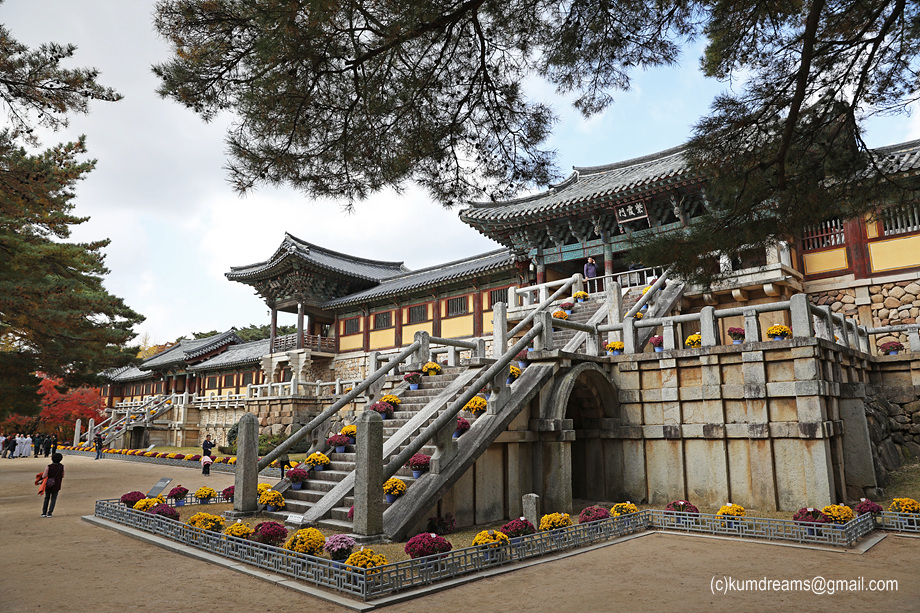Bulguksa Temple Stay: A Timeless Jewel of Korean Buddhism

Bulguksa Temple Stay: A Serene Sanctuary of Korean Buddhism
Nestled in the picturesque hills of Gyeongju, South Korea, Bulguksa Temple stands as a cultural and spiritual masterpiec. And it’s earning its well-deserved status as a UNESCO World Heritage site. Dating back to the Silla Dynasty, Bulguksa holds profound significance as a symbol of Korea’s enduring devotion to Buddhism.
Architectural Marvels: Bulguksa is renowned for its exquisite architecture. And it’s showcasing intricate carvings, majestic pagodas, and meticulous layouts that embody the principles of Buddhist cosmology. The Dabotap and Seokgatap pagodas, in particular, stand as iconic representations of Silla-era craftsmanship.
Cultural Significance: Steeped in history, the temple houses numerous relics and artifacts. And it’s offering a compelling journey through Korea’s rich Buddhist heritage. The Daeungjeon Hall, housing the Seokgamoni Buddha statue, exemplifies the fusion of spiritual significance and artistic brilliance.
Spiritual Retreat: Visitors to Bulguksa are greeted by an atmosphere of tranquility. With lush greenery and carefully manicured gardens providing a serene backdrop to the temple’s structures. The temple complex includes several prayer halls. And each contributing to the meditative ambiance that has drawn seekers and tourists alike for centuries.
Visitor Experience: A comprehensive visit to Bulguksa involves not only marveling at its historical and architectural wonders but also planning for a harmonious experience. Understanding the temple’s layout, exploring the nearby Seokguram Grotto, and timing the visit to coincide with seasonal beauty enhances the overall appreciation of this cultural gem.
In essence, Bulguksa Temple is not merely a collection of stones and timbers. It is a living testament to Korea’s enduring spiritual legacy, inviting all who visit to immerse themselves in the timeless serenity of Buddhist tradition.
Bulguksa Temple stay Information
Here is Bulguksa Temple Stay reservation site. And you can know what is a temple stay and some of Buddha’s words.
Bulguksa Temple Stay Timetable: It can be changed on certain circumstances.

Bulguksa Temple Stay: Tips for a Memorable Experience
Discover the renowned Bulguksa Temple with our essential tips for an unforgettable temple stay. Due to its immense popularity, early applications are recommended, ensuring you secure your desired dates. Failing to do so may result in an experience on unintended dates.
To fully immerse yourself in the temple stay and detach from worldly distractions, it’s advisable to distance yourself from the variety of snacks available at convenience stores. Within the temple, meals are limited to rice and water, making it beneficial to pack small snacks.
Arriving at Bulguksa Station by 3 PM on the day of your temple stay ensures a smooth transition as a guide will be there to pick you up, providing convenient transportation. For those using public transport, taking Bus 10 from Gyeongju Bus Terminal to Bulguksa Station and pre-requesting a pick-up is a viable option. (Office : +82-10-7773-0983. The office’s usually closed on Tuesday & Wednesday.)
As Bulguksa Temple is nestled in a forested area, it’s recommended to bring an extra layer or two, especially if your stay doesn’t coincide with the peak of summer. This advice ensures you’re adequately prepared for the natural surroundings, enhancing your overall temple stay experience.
Embark on a journey of self-discovery and tranquility at Bulguksa Temple, where ancient traditions and serene landscapes converge. Book your temple stay in advance for an enriching experience amidst the cultural and spiritual heart of South Korea.
Temple Stay Etiquettes
A temple is a sacred place for worshipping the Buddha. This is a place where monks and nuns live and practice. So, making loud noises, drinking alcohol, smoking inside the temple are strongly prohibited. Pagodas, stupas, stone lanterns or any other sculptures are all religious objects. Therefore, sitting or writing graffiti on them are considered disrespectful and are not allowed.
What do you wear to a temple stay?
Dress in the temple should be clean, neat and conservative. One should avoid bright colored clothes, outlandish clothes, heavy makeup, strong perfume and excessive accessories. One should not wear revealing clothing such as sleeveless tops, mini skirts and short shorts. Bare feet are not allowed in the temple.
Hap-jang: The way of greetings in a temple
Facing palms together is a standard way of greetings in the temple. In Korea, we call it ‘Hap-jang.’ I guess you can see this in many movies that a monk stars. When you do hapjang, you place your palms together in front of the chest. To greet someone, hold palms together and bow down. Putting our palms together means “center one’s mind” and “you and I are not two separate beings but one.”
Cha-su: Hand posture in a temple
“Cha-su” refers to the hand posture adopted while meditating without folding hands, either standing or walking. Typically, the term itself suggests lightly grasping the left hand with the right hand, meaning holding the back of the left hand with the right hand. When standing, it involves placing both hands naturally on the lower abdomen area, as if resting them gently, and when sitting, you can neatly place them on your knees. It’s mentioned that you can raise either the left hand or the right hand, as it doesn’t matter which hand is raised.